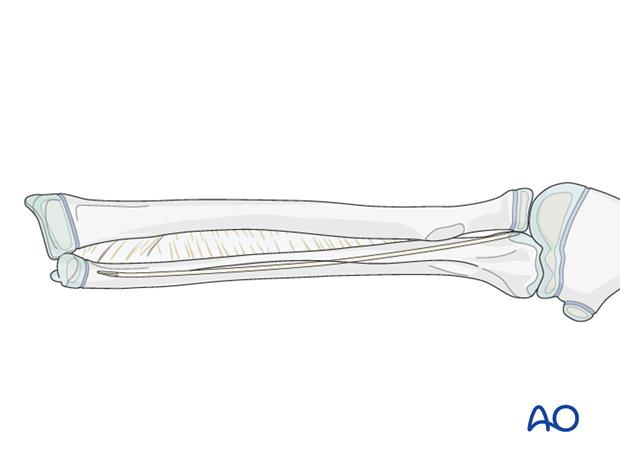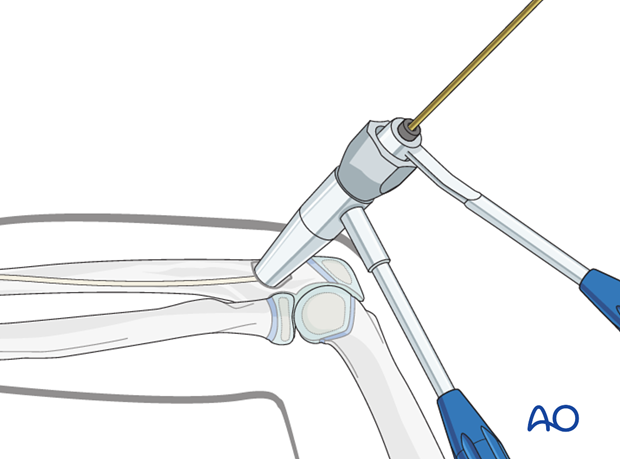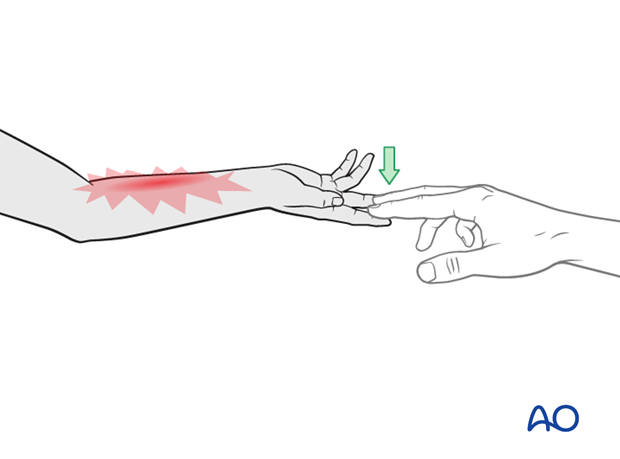ESIN
1. Introduction
General considerations
The ESIN method involves closed reduction and internal fixation with an elastic nail.
This method is a commonly used treatment option for displaced and/or unstable fractures of the forearm and can be used in any age group.

ESIN without image intensifier
ESIN method is possible without an image intensifier or peroperative x-ray examination.
The procedure is modified to include direct visualization of the fracture with an open approach. Stripping of the periosteum and disruption of the fracture hematoma are disadvantages.
2. Instruments and implants
Instrument set for ESIN
- 1.5-2.5 and occasionally 3.0 mm elastic nails
- Alternatively: 30 cm long, 1.6-2.5 mm K-wires with the tip bent
- Awl or drill
- Inserter
- Nail cutter
- Small hammer
- Optional: end caps

The end cutter is useful to avoid sharp ends and soft-tissue irritation.

Use of K-wires
Ring fixator wires may be used.
Bend the tip by approximately 30° to provide a gliding aid.

Nail diameter
For optimal reduction and intramedullary three-point fixation, the nail diameter should be between 60% and 70% of the medullary canal.
3. Patient preparation
This procedure is normally performed with the patient in a supine position.

4. Technique
Preliminary reduction
Preliminary reduction is not useful as deformity often recurs following manipulation.
Entry points
The proximal lateral entry point is in common use and shown in this procedure.
The distal medial entry point is an alternative and useful in midshaft and proximal 1/3 fractures of the ulna.

Opening the canal
Use small scissors or a surgical clip and small retractors to dissect to the bone under direct vision.
Place the awl or drill directly onto the bone and perforate the near cortex, under direct vision, perpendicular to the bone.
Do not hammer the awl to avoid perforation of the far cortex.
When the medullary canal is reached, lower the awl or drill 45° to the shaft axis and advance it with oscillating movements to produce an oblique canal.

Pitfall: Entry point through the olecranon
Do not introduce the nail through the olecranon.
This does not enhance fixation and causes troublesome soft-tissue irritation.

Nail precontouring
Precontour the nail to reproduce the geometry of the bowing deformity.

Nail insertion
Fix the nail into the inserter and pass it into the canal.

Pearl: insertion of nail tip perpendicular to shaft
Insert the nail with the tip perpendicular to the shaft axis until the far cortex is felt. Rotate the nail 180° and advance it using the curved side of the tip as a gliding aid.
If the tip is stuck in the far cortex and cannot be advanced, remove the nail and bend the tip to give a slightly more pronounced curvature.

Advancing the nail
Advance the nail with an oscillating maneuver with the precontouring in the same plane as the bowing down to the strong metaphyseal bone at the level of the distal ulna.
Pearl: A short working length (3-5 cm) between the entry point and the inserter improves control of the nail during insertion.

Pitfall: iatrogenic fracture
In young children, the nail tip may become stuck because of the narrow medullary canal.
Do not use a hammer if the nail is stuck as this risks iatrogenic fracture.
Withdraw by 2 cm, rotate the nail to free the tip and continue advancing.

Pearl: estimation of nail length
If an image intensifier is not available, estimate the optimum nail length with a second identical nail placed parallel to the initial nail.

Reduction
Rotate the nail 180° to counteract the deformity and re-anchor the tip in the cortex.
Full realignment of deformity may take several days.

Cutting the nail and wound closure
Cut the nail near the bone.
If a dedicated nail cutter is not available, cut the nail slightly shorter as the end will be sharper and this prevents skin perforation.
Gently withdraw the nail by 1 cm, cut the nail outside the skin and reinsert to the original position with an impactor.
Close the subcutaneous tissue and skin in a standard manner.

5. Option: end caps
End caps may be useful for stabilizing length unstable fractures.
The nail should finally be advanced using the beveled impactor.
A small end cap can be screwed in over the nail using the inserter.

6. Final assessment
Check the completed osteosynthesis with image intensification. These images should be retained for documentation or alternatively an x-ray should be obtained before discharge.
Make sure that the desired reduction has been achieved and the nail is of appropriate length.

7. Aftercare following ESIN
Immediate postoperative care
Whilst the child remains in bed, the forearm should be elevated on pillows to reduce swelling and pain.
They should be encouraged to use the arm.

Cast immobilization
Cast immobilization is not necessary and hinders early recovery of joint movement.
For Monteggia lesions treated with ulnar nailing, the forearm may be immobilized in a cast in the position of maximum stability of the radiocapitellar joint for 2-4 weeks.
Analgesia
Ibuprofen and paracetamol should be administered regularly during the first 4-5 days of injury, with additional oral narcotic medication for breakthrough pain.
If pain is increasing the child should be examined.
Neurovascular examination
The child should be examined regularly, to ensure finger range of motion is comfortable and adequate.
Neurological and vascular examination should also be performed.
Compartment syndrome should be considered in the presence of increasing pain, especially pain on passive stretching of muscles, decreasing range of active finger motion or deteriorating neurovascular signs, which are a late phenomenon.
See also the additional material on postoperative infection.

Compartment syndrome
Compartment syndrome is a possible early postoperative complication that may be difficult to diagnose in younger children.
The presence of full passive or active finger extension, without discomfort, excludes muscle compartment ischemia.
If there are signs of a compartment syndrome:
- If the child is in a cast, split the cast, along its full length down to skin level.
- Elevate the limb.
- Encourage active finger movement.
- Reexamine the child after 30 min.
If a definitive diagnosis of compartment syndrome is made, then a fasciotomy should be performed without delay.

Discharge care
Discharge from hospital follows local practice and is usually possible after 1-3 days.
The parent/carer should be taught how to assess the limb.
They should also be advised to return if there is increased pain or decreased range of finger movement.
It is important to provide parents with the following additional information:
- The warning signs of compartment syndrome, circulatory problems and neurological deterioration
- Hospital telephone number
- Information brochure
For the first few days, the elbow and forearm can be elevated on a pillow, until swelling decreases and comfort returns.
The arm can be placed in a sling for a few days until the patient is pain free. Many children are more comfortable without support.
Mobilization
Early movement of the forearm should be encouraged as soon as the patient is pain free.
Physiotherapy is normally not indicated.
Follow-up
The first clinical and radiological follow-up depends on the age of the child and is usually undertaken 4-6 weeks postoperatively.
At this point, the child should be able to move the forearm almost fully with some limited rotation caused by callus formation.
AP and lateral x-rays are required.
See also the additional material on healing times.
Nail removal
Nail removal is delayed until the fracture has modelled completely and can be performed as a day case, under general anesthesia.
The nail end in the proximal ulna can often be easily palpated.

In the distal ulna, the nail end may slip under tendons and nerves. This may irritate the soft tissues and make it difficult to palpate the nail tip.
Exposure of the nail end should be performed under direct vision with small retractors.
In most cases, a small bursa has formed. Once this bursa is opened, the end of the nail can be seen.
The nail can be removed with the extraction pliers, or a similar clamp. A strong needle holder is also useful.














